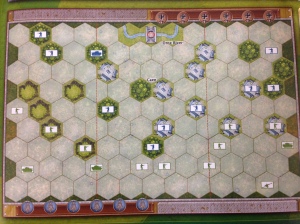Saint Roche Station is an early-war scenario for Memoir ’44 from the Equipment Pack‘s Additional Scenarios booklet. You can download the bonus scenarios from the Equipment Pack page in a single PDF, but oddly they have not been entered into the scenario database. The Equipment Pack scenarios are pretty uneven, and while this one is not the worst, it’s also got a pretty major problem.
Following some disastrous fights during the Battle of France, the British Expeditionary Force found itself cut-off from the rest of the French army and surrounded in the port-city of Dunkirk. Remnants of the British army engaged in some desperate rear-guard battles against the German advance to help the B.E.F. evacuate by sea. One such battle took place near Saint Roche Station, where the ad-hoc force of British rifle squads armed with HC Boys anti-tank rifles and light machine guns delayed elements of the 7th Panzer division avancing from the Somme to the Seine. A forward anti-tank gun managed to put one of the German tank sections out of action. Believing they faced a well-equipped enemy, the Germans slowed down and opted to pound the British positions instead of rushing them. This bought the B.E.F. some crucial time, but by nightfall the British forces had run out of ammunition and were forced to surrender.
The stage is set, the battle lines are drawn, and you are in command. The rest is history.
The scenario setup actually mirrors that situation reasonably well – the problem is that the rules of the game make this sort of historical battle not very fun. Here’s my photo of the map.

The Axis have an overwhelming advantage in total forces, and in mobility, and in firepower. The British infantry are dug into positions from which there is no retreat, and in which no counter-attack is feasible. Worse, the Axis artillery can break the British forces without an advance.
In reality, the Germans did not know the strength and composition of the British forces, and used their artillery to break an inferior force. That describes the worst possible sort of Memoir ’44 scenario, and as laid out, this is not a battle which I can recommend. The German armor is clustered into the corner, hedged in by an anti-tank infantry and a rail line. The British forces can only hope to get lucky on their plinks, and unless the Germans move forward they don’t have much hope of doing 5 medals worth of damage.
I found that changing out the German artillery piece for a 2nd mortar crew improved this scenario quite a bit. The German player had more of an incentive to move forward, and the British forward infantry had a greater chance to retreat for effect. Still, it’s not one that I can rate highly.
Overall Evaluation – 2/5 – I’d bump this to 3/5 with the suggested fix, but it’s still not great. The British just don’t have any options.
Balance Evaluation – strongly German favored – The Brits would need some truly spectacular luck to prevail in this one.
Plink-Fest Danger – High – With the German mortar and artillery, combined with their total superiority in the open thanks to the armor, they can win this one from range easily.
First-turn win danger – None


![IMG_0411[1]](https://memoir44fanatic.wordpress.com/wp-content/uploads/2014/09/img_04111-e1411452296170.jpg?w=225&h=300)





